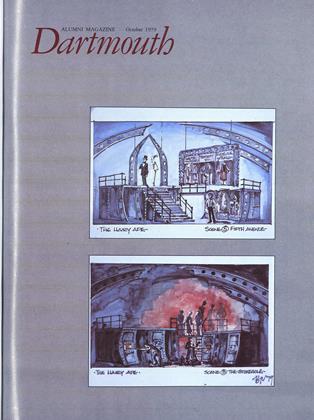Shortly before Convocation, President Kemeny announced the resolution of a problem that arose last spring during the discussion of minority issues at Dartmouth. The president's statement:
The Humphrey murals in the Hovey Grill [of Thayer Dining Hall] were painted by commercial artist Walter Humphrey '14 and commissioned in October 1937 during President Hopkins' administration. Their purpose was twofold: to provide decoration and background for sociability and informal discourse by students and faculty in a newly created center where beer and snacks were available and to commemorate the song written by Richard Hovey '85, which so many Dartmouth students had sung over many generations. In a sense, the Hovey Grill was a small prototype of the present Collis Center concept. There was no intent, or even a hint of apprehension, that these murals would ever be taken for anything but what, at the time, they were, namely a jovial, colorful contribution to a "pleasant, robust, masculine atmosphere which Hovey loved" and a spoof of the beloved but austere founder of the College.
The nation and its educational institutions do change. Dartmouth became coeducational, and the pervasive masculine atmosphere no longer characterizes the student body. Dartmouth also recommitted herself to the education of Native Americans. To do this with any chance of success, as I pointed out in announcing this dedication some ten years ago, it was and remains essential to make them feel welcome as full members of the institution. That the caricatured "Indian" in symbol, song, and mural, and the lampooned women of the mural, might be seen differently through the eyes of many current students, faculty, and administrators from the perceptions of former generations may not have been foreseen but, I trust, is now understood by alumni, whatever may be the nostalgia and warmth with which they remember the singouts and cheers of their undergraduate days.
All members of the Dartmouth family can take pride in the significant progress of the College's program for Native Americans. The auspices for the future are good, but will not be fulfilled without some special efforts and sensitive understanding of complex cross-currents.
Today we attract a sizable group of capable and promising Native American students. Every two years the College graduates more Native Americans than it did in the first 200 years of its history. In addition, our Native American Studies Program, under the able leadership of Professor Michael Dorris, has received national acclaim, and it has been suggested as a model which other colleges might well emulate.
Unhappily, the Humphrey murals have become a source of controversy and schism. Objections to the murals have been made for a number of different reasons. The greatest concern of Native Americans has been the presence of murals that caricature American Indians in a place used by many students and faculty for meals and entertainment. In discussions with the Native American community I made it clear that I would, under no circumstances, agree to censorship of art, and I was assured that this was not the issue. If the College wished to display the murals in a place where they could be studied as historic art, the Native Americans indicated they would support the move. With that agreement I asked the provost to appoint a committee to study how the murals could be displayed in a more appropriate setting than a dining room used by many persons offended by the murals.
The committee determined that the murals probably could not be moved without doing serious damage to them. They therefore came up with alternate suggestions for resolving the issue, one of which I found totally satisfactory.
In the future the Hovey Grill will be used for a rotating exhibit of College art with an emphasis on the history and traditions of the College. In the spring term, when the Hovey Grill is used for special events rather than daily dining, the original Humphrey murals will be on display.
It is my hope that all members of the Dartmouth family will take satisfaction that the College is beginning to fulfill a portion of the original commitment of the institution. Further progress in that direction depends to a great extent on our effectiveness in making every Dartmouth student feel a full member of the Dartmouth community. I will appreciate your support in that continuing effort to which I pledge my own energies.
 View Full Issue
View Full Issue
More From This Issue
-
 Feature
FeatureThe Trustees: 15 men and a woman with ultimate authority
October 1979 By Dan Nelson -
 Feature
FeatureTwo at the Top: On being a woman, a wife, a partner
October 1979 By Jean Alexander Kemeny -
 Feature
FeatureSummer Rep
October 1979 By Nancy Wasserman -
 Article
ArticleOffice of Development 1979 Report of Voluntary Giving
October 1979 -
 Article
ArticlePolyglot Son of Polyglots
October 1979 By NARDI REEDER CAMPION -
 Class Notes
Class Notes1978
October 1979 By JEFF IMMELT
Article
-
 Article
ArticleJUNIOR PROM
May 1916 -
 Article
ArticleFELLOWSHIPS ANNOUNCED FOR STUDY IN RESEARCH
MARCH, 1927 -
 Article
ArticleSuggestions for Children's Christmas Books
December 1937 -
 Article
ArticleSeason of Numbers
NovembeR | decembeR -
 Article
ArticleVISITING VOICES
JANUARY | FEBRUARY 2014 By Junot Diaz -
 Article
ArticleFaculty
FEBRUARY 1972 By ROBERT B. GRAHAM 40


